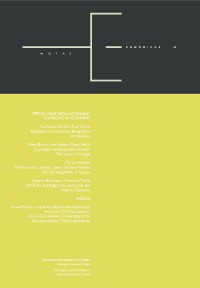Please use this identifier to cite or link to this item:
https://hdl.handle.net/10316.2/47742| DC Field | Value | Language |
|---|---|---|
| dc.contributor.author | Bação, Pedro | - |
| dc.contributor.author | Gaspar, Inês | - |
| dc.contributor.author | Simões, Marta | - |
| dc.date.accessioned | 2019-12-20T12:48:21Z | |
| dc.date.accessioned | 2020-10-04T14:48:48Z | - |
| dc.date.available | 2019-12-20T12:48:21Z | |
| dc.date.available | 2020-10-04T14:48:48Z | - |
| dc.date.issued | 2019 | - |
| dc.identifier.issn | 0872-4733 | - |
| dc.identifier.issn | 2183-203X (PDF) | - |
| dc.identifier.uri | https://hdl.handle.net/10316.2/47742 | - |
| dc.description.abstract | Neste texto estudamos o impacto da corrupção sobre o crescimento económico em Portugal no período 1980-2018. A abordagem empírica emprega um modelo VAR inspirado pela função de produção Cobb-Douglas tradicional. O modelo VAR inclui o stock de capital, as horas de trabalho, a produtividade total dos factores e o índice de percepções da corrupção (CPI) da Transparency International. O CPI combina informação sobre o nível de corrupção de diferentes fontes para cada país. A escala do índice vai de 0, o nível mais alto de corrupção, a 10, o nível mais baixo. A magnitude do efeito estimado da corrupção sobre o crescimento económico no modelo VAR sem restrições é grande (e positiva), mas do ponto de vista estatístico não é significativamente diferente de zero. Contudo, os resultados da estimação de um modelo VAR estrutural com restrições de longo prazo plausíveis do ponto de vista económico indicam que a redução da corrupção trará ganhos, ainda que relativamente modestos. | por |
| dc.description.abstract | In this paper we investigate the impact of corruption on economic growth in Portugal over the period 1980-2018. The empirical approach makes use of a VAR model inspired by the standard Cobb-Douglas aggregate production function. The VAR model includes the capital stock, hours worked, total factor productivity and the corruption perceptions index (CPI) of Transparency International. The CPI combines several sources of information on the level of corruption in each country. The scale of this index goes from 0, the highest level of corruption, to 10, the lowest level. The magnitude of the estimated effect of corruption on economic growth in the unrestricted VAR model is large (and positive), but statistically not significantly different from zero. However, the results from the estimation of a structural VAR model with economically plausible long-run restrictions indicate modest gains from reducing corruption. | eng |
| dc.language.iso | eng | - |
| dc.publisher | Imprensa da Universidade de Coimbra | - |
| dc.rights | open access | - |
| dc.subject | Corruption | eng |
| dc.subject | economic growth | eng |
| dc.subject | Portugal | eng |
| dc.subject | VAR model | eng |
| dc.subject | SVAR | eng |
| dc.subject | Corrupção | por |
| dc.subject | crescimento económico | por |
| dc.subject | Portugal | por |
| dc.subject | modelo VAR | por |
| dc.subject | SVAR | por |
| dc.title | Corruption and economic growth: the case of Portugal | por |
| dc.title.alternative | Corrupção e crescimento económico: o caso português | por |
| dc.type | article | - |
| uc.publication.collection | Notas Económicas nº 49 | - |
| uc.publication.firstPage | 11 | - |
| uc.publication.issue | 49 | - |
| uc.publication.lastPage | 33 | - |
| uc.publication.location | Coimbra | - |
| uc.publication.journalTitle | Notas Económicas | - |
| dc.identifier.doi | 10.14195/2183-203X_49_2 | - |
| uc.publication.section | Special Issue: Regulation and Economic Integration | - |
| uc.publication.orderno | 2 | - |
| uc.publication.area | Ciências Sociais | - |
| uc.publication.manifest | https://dl.uc.pt/json/iiif/10316.2/47742/266795/manifest?manifest=/json/iiif/10316.2/47742/266795/manifest | - |
| uc.publication.thumbnail | https://dl.uc.pt/retrieve/12120618 | - |
| item.fulltext | With Fulltext | - |
| item.grantfulltext | open | - |
| Appears in Collections: | Notas Económicas | |
Files in This Item:
| File | Description | Size | Format | |
|---|---|---|---|---|
| corruption_and_economic_growth__the_case_of_portugal.pdf | 1.29 MB | Adobe PDF |  |
Items in DSpace are protected by copyright, with all rights reserved, unless otherwise indicated.
